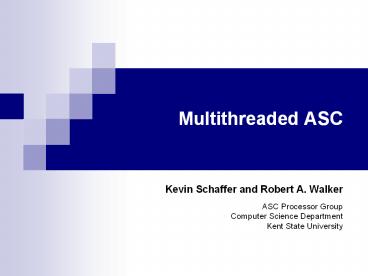Multithreaded ASC - PowerPoint PPT Presentation
Title:
Multithreaded ASC
Description:
... Time to perform a broadcast or reduction increases as the number of PEs increases Even for a moderate number of PEs, ... within the control unit Broadcast ... – PowerPoint PPT presentation
Number of Views:71
Avg rating:3.0/5.0
Title: Multithreaded ASC
1
Multithreaded ASC
- Kevin Schaffer and Robert A. Walker
- ASC Processor Group
- Computer Science Department
- Kent State University
2
Organization of an ASC Computer
3
Broadcast/Reduction Bottleneck
- Time to perform a broadcast or reduction
increases as the number of PEs increases - Even for a moderate number of PEs, this time can
dominate the machine cycle time - Pipelining reduces the cycle time but increases
the latency - Additional latency causes pipeline hazards
4
Instruction Types
- Scalar instructions
- Execute entirely within the control unit
- Broadcast/Parallel instructions
- Execute within the PE array
- Use the broadcast network to transfer instruction
and data - Reduction instructions
- Execute within the PE array
- Use the broadcast network to transfer instruction
and data - Use the reduction network to combine data from PEs
5
Scalar Pipeline
- Instruction Fetch (IF)
- Instruction Decode (ID)
- Execute (EX)
- Memory Access (M)
- Write Back (W)
6
Hazards in a Scalar Pipeline
7
Unified SIMD Pipeline
- Broadcast (B1...Bn)
- Reduction (R1...Rn)
- Number of stages is variable
- All instructions go through every stage
8
Diversified SIMD Pipeline
- Separate paths for each instruction type so
instructions only go through stages that they use - Stalls less often than a unified pipeline
organization
9
Hazards
10
Multithreading
- Pipelining alone cannot eliminate hazards caused
by broadcast and reduction latencies - Solution use instructions from multiple threads
to keep the pipeline full - Instructions from different threads are
independent so they cannot generate stalls due to
data dependencies - As long as there are a sufficient number of
threads, it is possible to fill any number of
stall cycles
11
Types of Multithreading
- Coarse-grain multithreading switches to a new
thread when the current thread encounters a high
latency operation - Fine-grain multithreading switches to a new
thread every clock cycle - Simultaneous multithreading can issue
instructions from multiple threads in the same
clock cycle - For a SIMD processor, fine-grain or simultaneous
multithreading is necessary as pipeline stalls
are relatively short and occur frequently
12
Multithreaded Control Unit
13
Reduction Hazard with a Single Thread
14
Reduction Hazard with Multiple Threads
15
Execution Time vs. Latency
16
Throughput vs. Latency
17
Multithreaded ASC vs. MASC
- A multithreaded ASC computer can execute at most
one instruction in a cycle - A MASC computer with j instruction streams can
execute up to j instructions in a cycle - In multithread ASC each thread can access every
PE - In MASC each instruction stream can only access
its partition of PEs - A multithreaded MASC computer could combine the
advantages of both
18
ASC
19
Multithreaded ASC
20
MASC
21
Multithreaded MASC
22
Multithreaded ASC Processor
- In order to validate simulation results and
estimate hardware costs, a prototype processor
was developed - Targeted for an Altera Cyclone II (EP2C35) FPGA
- Using an FPGA makes it possible to get detailed
measurements of speed and hardware cost
23
Additional Enhancements
- Flags (logical values) are a first-class data
types with their own set of registers and
instructions - Extra reduction operators
- Count Responders
- Sum
- Hardware semaphores for thread synchronization
24
Synthesis Results
- Targeted for an Altera Cyclone II FPGA (EP2C35)
- 16 x 16-bit PEs
- 16 hardware threads
- Clock speed 75 MHz































